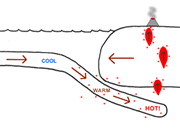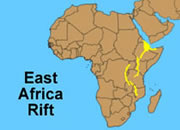Divergent plate boundaries are locations where plates are moving away from one another. This occurs above rising convection currents. The rising current pushes up on the bottom of the lithosphere, lifting it and flowing laterally beneath it. This lateral flow causes the plate material above to be dragged along in the direction of flow. At the crest of the uplift, the overlying plate is stretched thin, breaks and pulls apart.
Divergent Plate Boundary - Oceanic |
 |
When a divergent boundary occurs beneath oceanic lithosphere, the rising convection current below lifts the lithosphere, producing a mid-ocean ridge. Extensional forces stretch the lithosphere and produce a deep fissure. When the fissure opens, pressure is reduced on the super-heated mantle material below. It responds by melting, and the new magma flows into the fissure. The magma then solidifies and the process repeats itself.
The Mid-Atlantic Ridge is a classic example of this type of plate boundary. The Ridge is a high area compared to the surrounding seafloor because of the lift from the convection current below. A frequent misconception is that the Ridge is a build-up of volcanic materials; however, the magma that fills the fissure does not flood extensively over the ocean floor and stack up to form a topographic high. Instead, it fills the fissure and solidifies. When the next eruption occurs, the fissure most likely develops down the center of the cooling magma plug with half of the newly solidified material being attached to the end of each plate.
Visit the Interactive Plate Boundary Map to explore satellite images of divergent boundaries between oceanic plates. Two locations are marked: 1) the Mid-Atlantic Ridge exposed above sea level on the island of Iceland, and 2) the Mid-Atlantic Ridge between North America and Africa.
Effects that are found at a divergent boundary between oceanic plates include: a submarine mountain range such as the Mid-Atlantic Ridge; volcanic activity in the form of fissure eruptions; shallow earthquake activity; creation of new seafloor and a widening ocean basin.
Divergent Plate Boundary - Continental |
 |
When a divergent boundary occurs beneath a thick continental plate, the pull-apart is not vigorous enough to create a clean, single break through the thick plate material. Here the thick continental plate is arched upwards from the convection current's lift, pulled thin by extensional forces, and fractured into a rift-shaped structure. As the two plates pull apart, normal faults develop on both sides of the rift, and the central blocks slide downwards. Earthquakes occur as a result of this fracturing and movement. Early in the rift-forming process, streams and rivers will flow into the sinking rift valley to form a long linear lake. As the rift grows deeper it might drop below sea level, allowing ocean waters to flow in. This will produce a narrow, shallow sea within the rift. This rift can then grow deeper and wider. If rifting continues, a new ocean basin could be produced.
The East Africa Rift Valley is a classic example of this type of plate boundary. The East Africa Rift is in a very early stage of development. The plate has not been completely rifted, and the rift valley is still above sea level but occupied by lakes at several locations. The Red Sea is an example of a more completely developed rift. There the plates have fully separated, and the central rift valley has dropped below sea level.
Visit the Interactive Plate Boundary Map to explore satellite images of divergent boundaries between continental plates. Two locations are marked within the rift valley of East Africa, and another location is marked within the Red Sea.
Effects that are found at this type of plate boundary include: a rift valley sometimes occupied by long linear lakes or a shallow arm of the ocean; numerous normal faults bounding a central rift valley; shallow earthquake activity along the normal faults. Volcanic activity sometimes occurs within the rift.
Contributor: Hobart King
Publisher, Geology.com
Find Other Topics on Geology.com:
 | Rocks: Galleries of igneous, sedimentary and metamorphic rock photos with descriptions. |
|
 | Minerals: Information about ore minerals, gem materials and rock-forming minerals. |
|
 | Volcanoes: Articles about volcanoes, volcanic hazards and eruptions past and present. |
|
 | Gemstones: Colorful images and articles about diamonds and colored stones. |
|
 | General Geology: Articles about geysers, maars, deltas, rifts, salt domes, water, and much more! |
|
 | Geology Store: Hammers, field bags, hand lenses, maps, books, hardness picks, gold pans. |
|

|
 | Diamonds: Learn about the properties of diamond, its many uses, and diamond discoveries.
|
|



















